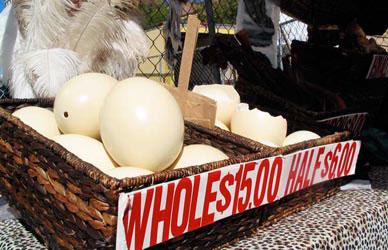

Multimedia
Shaggy Beasts: Hear more about farming Highland cattle
Related Stories
Links
Organics and Ostriches
Farmers plow out their own niche markets
The face of the family farm is getting a makeover – and it looks like an ostrich. As farmers look for new ways to earn a living and steward the earth in a changing world, the ostrich represents only one of many emerging niches in small- and medium-scale agriculture. Heritage breeds such as Highland cattle and Shetland sheep, as well as organic produce, artisan cheeses and community-supported agriculture, may well represent the future of family farming in Wisconsin.
Joe and Donna Dernbach operate Golden Dreams Ostrich Farm in Almond, Wis., about 20 miles south of Stevens Point. With their four sons they raise about 150 ostriches a year on three acres. In addition, almost 500 acres are devoted to cash crops of beans and sweet corn. Their niche is not to be taken less seriously than any other, even when the livestock stand a gangly six – or seven – or nine – feet tall and regard passersby with beady eyes.
“I think [the neighbors] still make fun of us after being in the business since 1994. They still think that this is a hobby, which I want to tell you, it is not!” Donna says. “This is more than a full-time job.”
The Dernbachs sell the ostrich meat, a red meat that Donna uses in place of beef, at the Dane County Farmers’ Market, in specialty grocery stores and over the Internet. The bones, tendons, livers and hearts are used for pet treats. They sell some of the eggs and incubate others. One ostrich egg, the largest of any living species and about the size of a jumbo papaya, has the same content as about 24 chicken eggs and, Donna says, a milder flavor. They sell the empty shells, which resemble porcelain, by the whole or half shell.
Selling a niche
Direct marketing at the farmers’ market is a common sales method among many niche farmers, not just the Dernbachs. After butchering their first Highland steer, John and Dorothy Priske took the meat to the Dane County Farmers’ Market.
“That set us off on a course that we never actually dreamed of,” John says.
At Fountain Prairie Inn & Farms, amid the drumlins of Fall River, 35 miles northeast of Madison, the Priskes raise 350 head of Highland cattle, a shaggy, curious breed native to Scotland, whose colors range from almost blond to dark titian. The males and females have horns, which they use to beat down weeds. The Priskes chose Scottish Highland cattle because of the breed’s tougher tongue and throat and for its browsing.
“God gave animals legs, and they prefer to move around. God gave grass roots, and that prefers to stay in one place. So under our system, we let the cattle be cattle, and they roam around, and they do the harvesting, and they do the fertilizing, and the grass stays in one place where it prefers,” John says. That grass-based system is good for the animals, the land, the air and the water, he says.
They also raise Berkshire hogs and run a bed-and-breakfast in their restored Victorian farmhouse. Sixty acres of their land is a restored, natural prairie and wetland.
Home I Mind I Body I Soul I Site Map
About Us I Contact Us I Business Partners I Archives
Copyright 2008 Curb Magazine